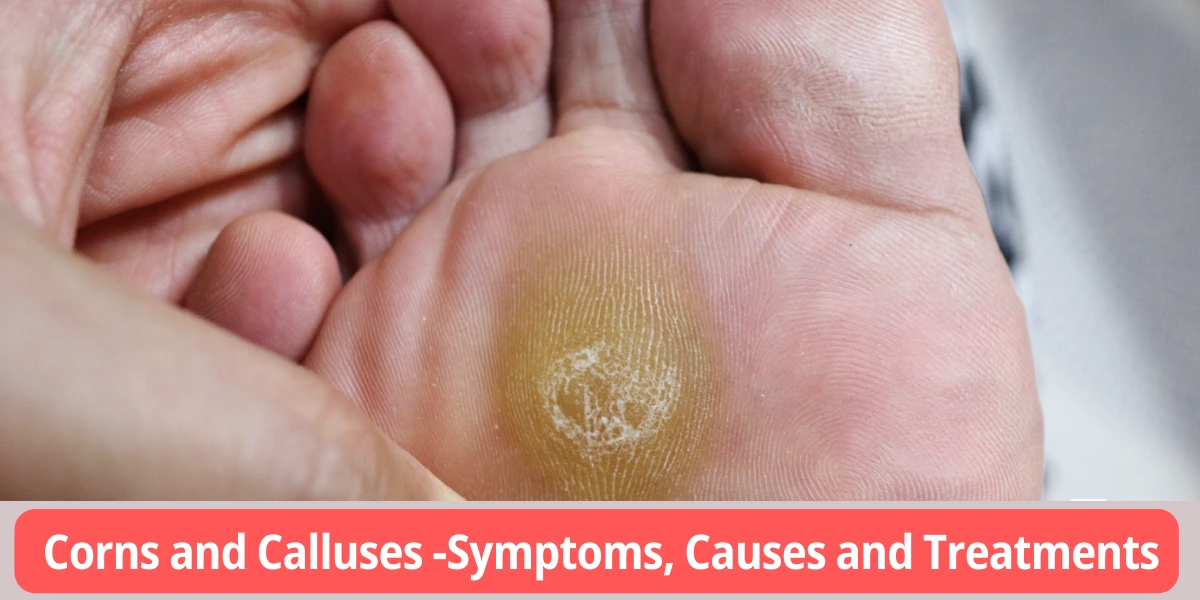Corns and calluses are common foot problems that can make your feet uncomfortable and affect your daily routine. Corns usually appear as small, thickened areas of skin on the tops and sides of the toes. Calluses, on the other hand, are larger and found on the soles of feet.
Recognizing Symptoms
Symptoms of corns and calluses can help in the early identification of these foot problems, and here’s what to look for:
Corn – Location : Usually on the toes or sides of the feet.
- Appearance : small, round, and may have a central core.
- Pain : They can be painful, especially when pressure is applied.
Calluses: Location : Mostly found on the soles of the feet.
- Appearance – larger, flat areas of thickened skin.
- Pain – They are often painless, but they can be uncomfortable.
The common causes of corns and calluses include wearing ill-fitting shoes that create friction, walking barefoot on hard surfaces, having foot deformities such as hammertoes, and wearing high heels that increase pressure on specific areas. It’s important to understand these root causes to effectively prevent and treat corns and calluses.
Effective Treatments for Corns and Calluses
1. Proper Footwear
Invest in shoes that provide ample space for your toes and have proper arch support. This can significantly reduce friction and pressure.
- Ample Toe Space – Shoes should not constrict your toes. Opt for designs that allow for natural movement, reducing the risk of friction.
- Proper Arch Support – Look for shoes with adequate arch support. This helps distribute pressure evenly across the foot, minimizing the likelihood of corns and calluses.
Remember, the right shoes not only provide comfort but also play a pivotal role in preventing these foot conditions.
2. Cushioning Pads
Use cushioning pads or insoles to alleviate pressure on affected areas. These can be particularly helpful for individuals with corn.
- Pressure Alleviation – These pads and insoles provide an extra layer of cushioning, reducing the pressure on specific areas of the foot.
- Enhanced Comfort – By absorbing shock and minimizing friction, cushioning pads contribute to enhanced overall comfort, making it easier to manage existing corns.
Ensure you choose pads or insoles designed for your specific foot shape and the location of the corns.
3. Regular Moisturizing
Keep your feet well-moisturized to prevent the buildup of dead skin cells. This simple step can go a long way toward preventing corns and calluses.
- Preventing Dryness – Dry skin is more prone to developing calluses. Regularly moisturizing your feet keeps the skin supple, reducing the risk of callus formation.
- Dead Skin Cell Prevention – Moisturized skin is less likely to accumulate dead skin cells, a primary contributor to corn. Pay extra attention to areas prone to dryness.
4. Avoiding High Heels
Minimize the use of high heels, especially if you’re prone to developing corns and calluses. Opt for comfortable, supportive shoes instead.
- Uneven Pressure Distribution – High heels concentrate pressure on the front of the foot, increasing the risk of corns and calluses.
- Toe Compression – Pointed toe boxes in high heels can squeeze toes together, promoting corn formation. supportive shoes with lower heels for everyday wear. Save high heels for special occasions to reduce the strain on your feet.
Why Choose Dr. Chetan Oswal For Foot Care?
If you’re looking for foot care, Dr. Chetan Oswal is an excellent choice for your foot care
Specialized Expertise – Dr. Chetan Oswal is an expert in addressing a wide range of foot and ankle issues.
Personalized Care – Dr. Chetal Oswal provides individualized care to each patient, tailored to their unique needs, ensuring that they receive the best possible treatment.
Conclusion
In conclusion, corns and calluses are common foot problems that can be uncomfortable and affect your daily life. However, by understanding the causes and symptoms, you can take steps to prevent and treat them. Investing in proper footwear, using cushioning pads, regular moisturizing, and avoiding high heels are effective home solutions. When home solutions are not effective, seek professional help from an expert like Dr. Chetan Oswal, a leading ankle and foot specialist in Pune. He can provide specialized treatment and personalized care to address a wide range of foot and ankle issues.





